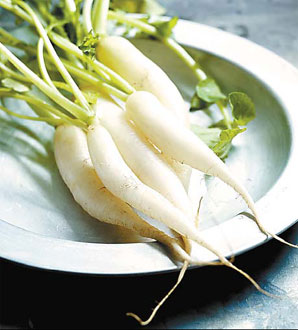A versatile vegetable when it comes to the crunch
Until my China move, recognizing a radish (luo bo) was not a challenging thing: small, red and spherical - my mom had always grown them at home and used them raw in salads. That was that. An enlightening trip to my local green grocers when I first arrived revealed radishes in many guises and with many more culinary possibilities.
Varieties of radish are found widely throughout Asia and Europe, and they are part of the encompassing Brassica family (whose members include cabbages, broccoli and mustard); it is a close relative of the turnip.

Their flesh has a crisp, crunchy texture and a unique peppery flavor caused by a chemical reaction that occurs between the enzyme myrosinase and another chemical in the radish, brought together when the vegetable is munched.
Nutritionally, radishes have a high water content making their calorie count per 100g very low at 20kcal. They contain reasonable amounts of vitamin C, folic acid and potassium which, along with most other vegetables, make them heart-healthy.
The white radish (bai luo bo) is perhaps the most common form over here - resembling a seriously oversized white carrot and often referred to in English by its Japanese name, Daikon. In Japan they are often shredded and served as a crisp accompaniment to sashimi.
More often, the Chinese use white radish and also their elongated red counterparts in soups and stir-fries. Cooking reduces the piquancy of their flavor, and they take on a silky texture that absorbs other flavors well.
In Cantonese cuisine, a savory white radish cake called Luobo Gao is typically served at Chinese New Year, but can be found year round in dim sum restaurants. This is a combination of grated white radish and rice flour flavored with dried mushrooms, dried shrimps and Chinese sausage which is steamed for a number of hours and fried in slices before serving.
Certainly the prize for best looking radish goes to xin li mei, which itself means beauty inside the heart - an apt description indeed. When sliced open, the green white exterior of this ball-shaped radish reveals a bright magenta core.
|
Radishes contain reasonable amounts of vitamin C, folic acid and potassium, making them heart-healthy. Quanjing |
In Chinese restaurants, this is usually served raw with a little garlic and vinegar dressing. For an eye-catching summer salad, combine thin slices of xin li mei with peeled and cored chunks of cucumber and crumbled feta cheese, then dress with torn mint leaves, a drizzle of olive oil and some fruity vinegar.
If xin li mei is not available, the more familiar small red radishes (xiao luo bo) can be substituted.
Do not overlook the possibilities for leftover radish tops. Their fiery bite contrasts nicely when paired with milder salad leaves and they are also fantastic made into soup.
Saut two coarsely chopped potatoes and an onion until soft, then add six generous handfuls of radish tops and some chicken stock to the pan and cook for 10 minutes. Finally add the juice and rind of a lemon, season with salt and pepper and then puree. This vibrant emerald broth can be iced or served hot.
A final word for any singletons out there, please refrain from dwelling on these snippets of information too much. When quizzing a Chinese friend about radishes she informed me that according to Chinese folklore - if a single man dreams about radishes it means his future wife will be a cruel woman, whilst a radish-themed dream for a woman indicates an impoverished man in her destiny.
This nutrition-related column is written by Nina Lenton, a qualified dietitian living and working in Beijing. Contact her at nina.lenton@ikang.com.
(China Daily 04/16/2008 page19)















